The 165 Ontario Story
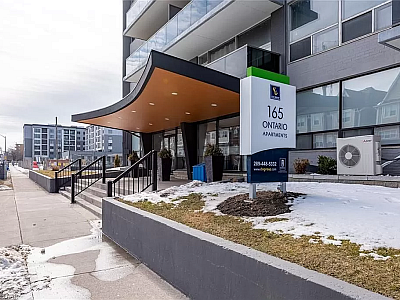 On the surface, The 165 is a more or less ordinary apartment building. But, with frequent changes in ownership, it has become a glaring example showing how landlords all across Ontario are abusing Above Guideline Increases (AGIs) to jack up rents for existing tenants and present an artificially high profit to investors.
On the surface, The 165 is a more or less ordinary apartment building. But, with frequent changes in ownership, it has become a glaring example showing how landlords all across Ontario are abusing Above Guideline Increases (AGIs) to jack up rents for existing tenants and present an artificially high profit to investors.
Originally intended as an assist to Ontario's landlords who have to deal with extraordinary expenses, AGIs are no longer coupled to the desire to repair or maintain buildings. They are now being used as a profit making tool by capitalizing on a flaw in the Residential Tenancies Act. Ontario's corporate landlords have turned a corner from filing AGIs because they did renovations to doing renovations so they can file AGIs.
The game is exposed by repetition. As each new landlord has taken over, the cycle of acquire, renovate, litigate and move on becomes more and more obvious. Once understood, this province wide game they play shows itself as a major component in Ontario's current rental housing crisis.
About AGIs
An Above Guideline Increase (AGI) is a lawsuit in which a landlord is suing his tenants for more rent. If successful, they can increase rents by up to 9% over and above the provincially allowed rent increases. This is taken as up to 3% per year for the first 3 years and, after that, can last for 25 years or more.While it is true that a landlord can renovate and redecorate as he sees fit, the rent increases are not a given. AGIs require approval from the Landlord Tenant Board in a Tribunal hearing. The landlord must justify each of his claims to the satisfaction of an Adjudicator before it can cause an increase in rent.
As we will see below, this is a deeply flawed process.
Building history
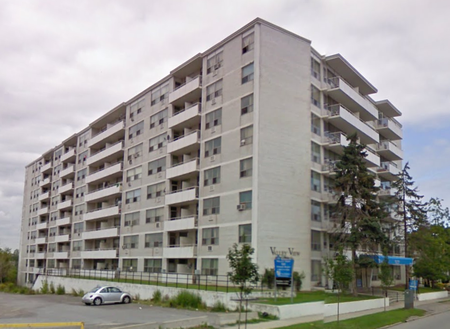 To fully expose the Landlord's game, we first need to look at the building's history.
To fully expose the Landlord's game, we first need to look at the building's history.
The "165 Ontario Street" address first appeared in St. Catharines Ontario's municipal registries in 1965. Originally named "Lucerne Apartments", this building is home to about 300 people in 157 units.
When first built, this was a moderately luxurious building with larger than average apartments. The building's skin was ivory coloured glazed brick. The lobby was furnished with couches and a waterfall aquarium that was home to half a dozen huge goldfish. There was music in the elevators and a small office where you could connect with the superintendent and maintenance man who both lived in the building.
When I moved in, on July 2 1984, The 165 was home to a surprising number of long term residents, a couple of whom were the first renters of their units. Others had already been here for 10 and 15 years. There was a sense of community in the building as we all got to know one another and exchanged greetings in the halls. It wasn't uncommon for groups of us to congregate on the front steps during nice weather and have some truly fun conversations.
For reasons unknown, the building had been allowed to deteriorate somewhat and was in a moderate state of disrepair. The hallways were clean but the carpets, doors and walls were showing signs of wear. The apartments were in a general state of good repair. Everything worked well enough but the walls needed a good coat of paint and my apartment needed floor refinishing.
In the late-1990s, by municipal orders, the building was placed under control of a management company who were commissioned to restore the building. These extensive "top down" Renovations took almost 2 years to complete. The result was a very nice 60s-chique building that was almost empty as people had moved out to escape the noise and disruptions.
Once fully renovated, the building was turned over to a second management company who took on the task of re-renting a nearly empty building. After causing considerable chaos with a revolving door of rentals and evictions (both of which they got commissions for) their management contract finally expired and control reverted to the original owners; A&L Investments.
Most buildings get this kind of major renovation once in their lifetimes. The original decor stood for 35 years without major issues. There seemed little reason to think the renovations completed in 2000 would be any less durable, so life went back to normal.
This, however, was not to last.
The onslaught
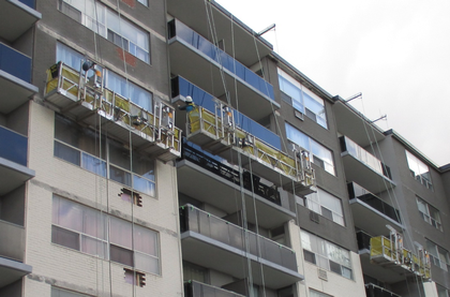 Picture this: You are finally getting a well deserved night of catch-up sleep and suddenly, at the crack of dawn, you are jolted wide awake by the deafening rattle of a jackhammer right on your balcony and half a dozen workmen clustered just inches outside your window.
Picture this: You are finally getting a well deserved night of catch-up sleep and suddenly, at the crack of dawn, you are jolted wide awake by the deafening rattle of a jackhammer right on your balcony and half a dozen workmen clustered just inches outside your window.
Now imagine it's been like this for 15 years. The work goes on almost every working day and sometimes on weekends with things being done and then redone as the building repeatedly passes from one landlord to the next.
Since 2007, tenants of this building have been put through near continuous intrusions from workmen, jackhammers, power tools, loud noise, high dust levels, repeated water shutdowns and more as they are repeatedly inconvenienced and endangered by the latest round of renovations.
This is always followed by rent increases, either through tenant desertion opening the vacant apartment to market value rents or through Above Guideline Increases (AGIs) in their rents for the remaining tenants.
Definitely not fun.
Renovation fever
This all started when the original owners sold the building to Transglobe Property Management who immediately launched into a round of extensive Renovations that ran from 2008 to 2010.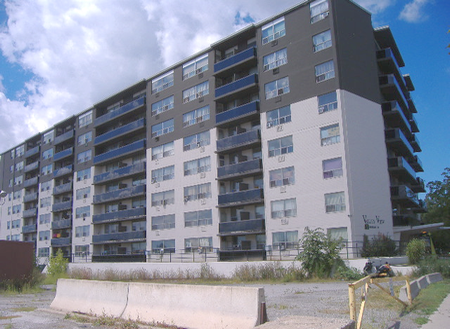
Then in 2011, TransGlobe failed in the aftermath of an expose from CBC Marketplace. The company was privatized then reformed as Starlight Investments who took control of the building in early 2012. They too immediately launched into a round of even more extensive Renovations as soon as they took possession of the property.
By mid 2013, the building had been completely transformed both inside and out. The outer skin was now painted two-tone brown, the balconies were replaced with tinted glass, the lobby and hallways had been redone repeatedly and the interiors of almost all of the apartments had been completely redesigned at least once.
But it didn't end there. In 2016, the building passed to NorthView REIT who did yet another round of Renovations beginning as soon as they took over the building.
Finally in 2020, Starlight bought out NorthView, regained control of the building for a short while and then sold it to CLV InterRent who took possession in April of 2021. These guys are ambitious. They've given us more than 2 years of the most intense Renovations yet.
Yes, four landlords in a row acquired a recently renovated building and immediately launched into mostly duplicated major renovations.
AGI playbooks
One has to wonder why a new landlord would come in here like a drunken bull in a china shop, changing everything in sight with no consideration for work already done or the tenants living here.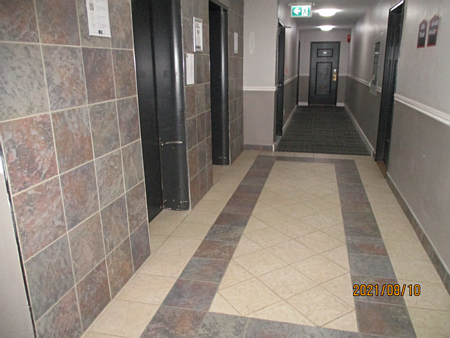
AGIs were originally designed to help landlords who didn't have the financial resources to cover extraordinary expenses. When working in partnership with tenants, they serve this purpose very nicely. The landlord upgrades the property and tenants get increased value from their homes. Sometimes this will justify a small rent increase.
But that is not how they are being used.
Today's landlords come out swinging. When they acquire a new property, they immediately launch into mass renovations, making large capital investments in the building. If you scan down the Full List of renovations done on this building you will see that an extraordinary amount of work has been done in a surprisingly short space of time.
We need to appreciate that at no time after the first round of renovations, ending in 2000, has this building actually been run down or in bad condition. When InterRent acquired this building, they got a freshly renovated building from Northview, who got a fully renovated building from Starlight, who got a mostly renovated building from TransGlobe, who bought a nicely restored building from A&L Investments. Any of them could have rented it out for several years before major fix-ups were needed. But, as each new landlord has taken control of the building, they immediately launched into a top to bottom renovation and make-over of the whole building.
The game is exposed by the repetition of nearly the Same Renovations as each new landlord took his turn. That they had just purchased freshly renovated building from their predecessor, does not matter to them. They don't care about the building's history or condition. They're going to do this work anyway.
What we are seeing is an "AGI Playbook", a list of renovations to be performed, even if unnecessary, then followed by AGI applications. These playbooks are written into a landlord's business plan, solely as a means to motivate investors. It is used to give a much larger impression of profitability; all of it at the tenant's expense.
Follow the money
Not so long ago, an apartment building was a long term investment, using rental cash flow to pay the bills until it acquired enough value to sell for a nice profit. The payoff was in the building, not the rent.That all changed in 1993 when Landlords were allowed to trade on the stock market as Real Estate Investment Trusts (REITs). They are now almost totally investor driven. The time scale for return on investments has gone from years to days. Corporatized landlords no longer work for their tenants. Now it is their investors they try to please with constantly increasing dividends and rising share prices. Suddenly, the payoff is in the rent.
There's a new hog at the trough. Where rent money originally flowed from tenant to landlord, it now flows from tenant to shareholder with their ever present expectation of "continual growth".
Bypassing rent controls
The province of Ontario has a system of Rent Controls that limit how much a landlord can legally increase rent from year to year.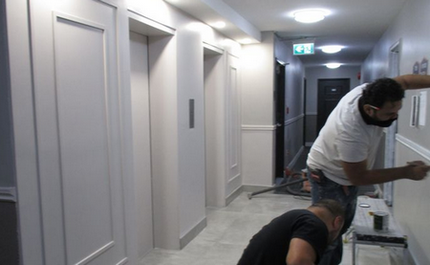
This puts corporate landlords up against a hard limit. Once all their apartments are rented, their income plateaus. It increases only once a year by the amounts allowed by rent controls. They now need to find ways to increase property value and cash flow or they risk an investor sell-off that could bankrupt them.
Many landlords have now taken to aggressively bypassing Ontario's rent controls as a means to increase both rental income and portfolio values on their properties.
-
Fortunately for landlords -but not for their tenants- Ontario's rent controls are rather leaky:
- They do not apply to vacant apartments
- Buildings first occupied after November 15th of 2018 are exempt.
- They allow Above Guideline Increases (AGIs) in rents for occupied units.
Renovations, being capital investments, are a prime tool. There is no denying the effectiveness of this strategy. Using AGIs, this building's multiple landlords have managed to Drive Up Rents for long term tenants by nearly double the provincially allowed rates.
The AGI's secret value
Beyond simply applying for a rent increase, AGIs have a second use. Each capital expense item claimed on an AGI application also carries a Lifetime And Value that is visible on both the application and final order. Once approved by the Landlord Tenant Board, these can be used by a landlord to present an artificially high state of worth.-
If we take the example of a $1,000,000 landlord who does a $200,000 renovation with a 10 year lifetime:
- Initially it looks like he had an $800,000 year.
- But with a court document validating his capital expenses he can take the $200,000 and apply at least most of it to his property value as an improvement.
- Now he's back to a $1,000,000 year.
- Then with the same documents, he can amortize the capital expense over the lifetime of the project, meaning that he's only writing down $20,000 a year, for 10 years. (an apparent increase of $180,000)
- So now it looks like he just had a $1,180,000 year.
Obviously, they are spending money to make money. It increases share values and drives investor interest by providing the appearance of "continual growth".
False claims
Above Guideline Increases are not automatic. A landlord does not get to increase rents solely because he spent some money. Each claim on an AGI has to be justified according to Inclusions and Exclusions set out in the Residential Tenancies Act and its regulations. So, we need to ask how much of the renovation was actually necessary, restorative work that would qualify for a rent increase.For example:
What are the odds that our balconies needed to be redone 4 times in 20 years when the originals stood for 35 years?
These pictures are typical of hundreds that were taken just a few days before CLV started redoing our balconies. Looking through them, I don't see balconies that were deteriorating or in need of repair. I see nice balconies that people were using and enjoying. But, that didn't stop CLV from spending over a year "fixing" them.
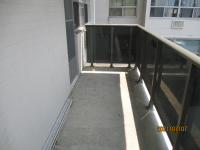
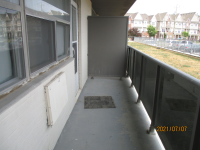
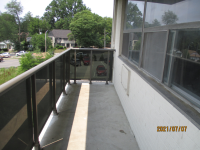
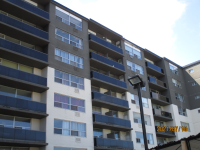
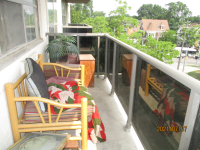
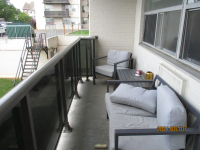
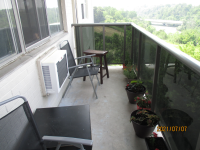
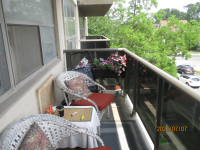
A similar examination of the work done on the elevator landings, lobby, apartment doors and in individual apartments will raise the same questions about the need and reasons. But, landlords are doing this work anyway.
By all indications, very few of these AGI claims should be approved and yet virtually all of them are.
The evidence problem
 The obvious question at this point is: "If these AGI claims are not credible then how are landlords getting them approved?"
The obvious question at this point is: "If these AGI claims are not credible then how are landlords getting them approved?"
That part is simple: They lie.
A Tribunal hearing will always come down to a contest between landlord and tenant evidence, hinging on the Residential Tenancies Act's Inclusions And Exclusions. If the tenants can offer no evidence in rebuttal the landlord almost always wins.
In the process of planning a project and preparing for the renovations and the inevitable AGI, a landlord has every opportunity to build believable reasons that will succeed if not challenged.
However; a landlord is under no obligation to inform his tenants that work being done will be part of an AGI application. So tenants don't get Involved until well after the work is completed, the workspace is altered and the Notice of Hearing and AGI application arrives. This effectively prevents tenants from documenting the unaltered workspace, gathering evidence of its condition and building a case in rebuttal.
Given that a landlord is not required to inform tenants of capital work that does not affect their "reasonable enjoyment" in their homes, it even becomes possible for them to claim items tenants know nothing about before receiving the Notice of Hearing.
-
In most hearings, this results in a situation where:
- The landlord knows what is going on but isn't being honest.
- The tenants know what is going on but can't prove it.
- The legal representatives know only what they are told
- The Adjudicator knows nothing about the building at all
On top of this there is the matter of simple disbelief. Nobody thinks a landlord is going to spend millions of dollars on unnecessary renovations; especially when public examples of them not doing ordinary maintenance are so common. The situation is counter-intuitive to the point where it is often dubbed a "conspiracy theory".
Thus, most AGI applications are approved without challenge.
Researching this apparent unfairness on the Canadian Legal Information Institute (CanLII) database very quickly shows that virtually all reported AGI tribunals were heard without challenge and rent increases were almost always granted. Phrases such as "The tenants lead no evidence" are common as are the tenants' desperate appeals to reason. It should also be noted that only a small portion of these cases are actually reported and the ones resolved by consent orders and mediation are not reported at all. If all AGI cases were reported, it is likely this picture would be much darker.
It is impossible to see this as anything but a deeply flawed process that openly invites abuse.
InterRent's playbook
Our current landlord's playbook is exposed on page 11 of their June 2021 Quarterly Report to their investors, published at the time they acquired control over this building.They talk about their "Repositioning" strategy of upgrading nearly everything to a more prestigious standard. Then on page 12 they talk about delivering high end amenities that are nice but not necessary. This is renovation work that is being done whether it is structurally necessary or not and they have been Very Busy at it.
Effectively, they are using AGIs to sell luxury to their investors... at their tenant's expense.
On September 18, 2023, tenants received their first Notice Of Rent Increase due to an AGI Application InterRent has filed. On February 14th 2025 we received the notice of hearing for the AGI, begging for an 8.27% rent increase that could last up to 20 years, $2,292,473.66 in total. You can track the progress of this case in the AGI Tracker.
The game never ends.
Province wide
The abuse of AGIs is much bigger than most people think it is. There is considerable evidence that use of AGI Playbooks is provincial in scale and most likely involves thousands of buildings.I first got into this issue in 2014, after a disastrous first hearing in SOL-40297-13. It went so badly off the rails that I filed a review request and got an order for a de novo (new) hearing. When investigating Starlight (our landlord at that time) for the tenant's defense, I initially discovered another 18 Buildings that were painted like The 165 and had identical tinted glass balconies. Then, on deeper investigation, using Google Street View, I uncovered a total of 100 Buildings from their portfolio that were all done the same way within a two year period. It is simply not rational to believe that such a large cluster of buildings of varying age, size and structure, scattered all over the province would all need identical renovations at practically the same time. Something else was going on behind the scenes. Further investigation revealed this was a Corporate Branding scheme; Starlight's playbook.
Mine is not the only evidence of this underhanded activity. A February 2021 Report from Renovictions-To shows us in stunning detail just how bad and how widespread this disgraceful practice has become. A recent CBC News Story carries a list of over 2,600 Ontario buildings affected by AGIs. A Second Article details 275 buildings in the city of Hamilton alone.
There has been a steady increase in AGI applications. Since the 2006 enactment of the Residential Tenancies Act (RTA) and a 2007 shift in Tax Exemptions from the Harper government, this once obscure process is being used more and more. The Landlord and Tenant Board's annual report for 2005-2006 reported 209 L5 (AGI) applications. This has risen to 613 in their 2021-2022 report which also notes an all time high of 758 in 2019. This is an overall increase of 300%.
Socially harmful
Coupled with the current shortage of rentable units in the province, this massive loophole has become a prime tool for landlords to increase both rents and property values, giving investors a stronger incentive and providing higher returns for shareholders. All done at the tenant's expense.After more than a decade of abusing AGIs, it is likely landlords are collecting literally millions of dollars in undeserved rent increases, province wide, every month. In this building alone, landlords have used AGIs to Force Tenants to pay for over $2,750,000 in renovations, most of which are questionable at best.
Many landlords now display a strong sense of entitlement. Not only do they think they are allowed to circumvent the province's rent controls, they seem to think tenants automatically owe them the money. AGIs have become the goose that lays golden eggs and it's very unlikely landlords will give that up any time soon.
The most vulnerable -those on pensions and social assistance- are the most severely impacted. Many find themselves involuntarily living in construction zones, enduring months or years of disruption only to be sued for the cost at the end. Many are at their budgetary limits and some are even ending up homeless because of it. The load on social services such as food banks and clothing charities is increasing. Local economies suffer as people have less to spend and local businesses are feeling the strain.
The fix
The principles of Natural Justice upon which the Ontario Tribunals are based require that for a fair hearing both parties must be equally able to provide testimony and evidence before a neutral adjudicator. It is clear that the current process for capital expenditures in AGIs does not even get close to this requirement. In most cases the tenants are blocked from providing credible evidence and testimony in counter. This, as explained above, is a result of bringing the tenants into the process long after any evidence they might use in a hearing has been destroyed by the work performed.Fortunately, the fix is quite easy.
Simply modify paragraph 126(4) of the Residential Tenancies Act to require a landlord to announce their intention to file an application for an Above Guideline Increase before the work begins:
-
(4) If A landlord intends to make an application under this section that includes a claim for capital expenditures, the landlord shall post notice to the tenants 60 days before work commences describing the nature of the work to be carried out and the intention to make an application.
(4.1) When an application is made under this section that includes a claim for capital expenditures, the landlord shall make information that accompanies the application under subsection 185 (1) available to the tenants of the residential complex in accordance with the prescribed rules.
Since the landlord is already obliged to post notice under Ontario Regulation 516/06 part 8, in order to avoid rent abatements, this adds only the small additional burden of announcing their intention to file for an AGI. But for tenants it provides a window of opportunity for them to examine the unaltered worksite and gather evidence and information about it's condition. This in turn allows them to participate fully with evidence and testimony in the resulting hearings.
The benefit of this is two fold:
First: it restores fairness, allowing equal participation by both parties in a tribunal hearingSometimes the simplest changes make all the difference.
and
Second: tenants will be able to expose false claims, preventing abuses by landlords.
Lets keep everyone honest: Make the process fair!